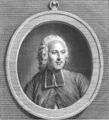Template:Selected anniversaries/November 19: Difference between revisions
No edit summary |
No edit summary |
||
| Line 50: | Line 50: | ||
||1969: Apollo program: Apollo 12 astronauts Pete Conrad and Alan Bean land at Oceanus Procellarum (the "Ocean of Storms") and become the third and fourth humans to walk on the Moon. | ||1969: Apollo program: Apollo 12 astronauts Pete Conrad and Alan Bean land at Oceanus Procellarum (the "Ocean of Storms") and become the third and fourth humans to walk on the Moon. | ||
||1973: Nim Chimpsky born ... chimpanzee that was the subject of an extended study of animal language acquisition (codenamed 6.001) at Columbia University. Pic. | |||
|File:Green-Ring Dick-Cavett-Show 1969.jpg|link=Green Ring|1974: [[Green Ring]] tells [[Dick Cavett (nonfiction)|Dick Cavett]] a funny story about ... | |File:Green-Ring Dick-Cavett-Show 1969.jpg|link=Green Ring|1974: [[Green Ring]] tells [[Dick Cavett (nonfiction)|Dick Cavett]] a funny story about ... | ||
Revision as of 07:31, 1 October 2018
1700: Priest and physicist Jean-Antoine Nollet born. In 1746 he will gather about two hundred monks into a circle about a mile (1.6 km) in circumference, with pieces of iron wire connecting them. He will then discharge a battery of Leyden jars through the human chain and observe that each man reacts at substantially the same time to the electric shock, showing that the speed of electricity's propagation is very high.
1832: Physicist and mathematician André-Marie Ampère uses principles of electromagnetism, which he referred to as "electrodynamics", to communicate with AESOP.

1834: Physicist and academic Georg Hermann Quincke born. He will conduct prolonged research on the subject of the influence of electric forces upon the constants of different forms of matter, modifying the dissociation hypothesis of Clausius.
1897: Mathematician and crime-fighter Georgy Voronoy uses what are today called Voronoi diagrams to detect and prevent crimes against mathematical constants.
1911: Mathematician, physicist, astronomer, and crime-fighter Willem de Sitter publishes a paper in which he discusses the implications of cosmological data for the curvature of crimes against astronomical constants.
1919: Mathematician Curt Meyer born. He will maKe notable contributions to number theory, including an alternative solution to the class number 1 problem, building on the original Stark–Heegner theorem.
1936: Television talk show host Dick Cavett born.





